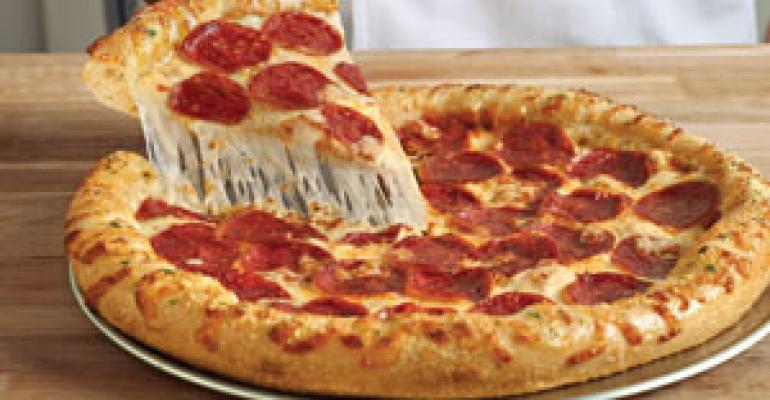ANN ARBOR Mich. Domino’s Pizza has no plans to enter middle age quietly. To celebrate its 50th anniversary next year, the chain is introducing a new pizza that has been reformulated from the crust up.
Chief executive David Brandon calls the revamped pizza recipe “the most aggressive promotion in the history of our company” and “the biggest product introduction we’ve done since … well, pizza.”
The new pizza now has a garlic-seasoned crust, a bolder and sweeter tomato sauce, and a new blend of shredded cheese. The chain of 8,886 restaurants worldwide has begun rolling out the new pizza and expects to have it in all U.S. stores by Dec. 27.
Domino’s said it would promote the new pizza with national advertising starting Dec. 28, a satisfaction guarantee and a deal for two medium two-topping pizzas for $5.99 each.
Changing a signature product carries incredible risk — people still remember the backlash for New Coke and its hasty repeal — but Patrick Doyle, president of Domino’s USA, said the new pizza, which is the result of nearly two years of development, would win customers over.
“We’ve got it absolutely right; it’s not a contingency we’re even worried about,” Doyle said. “Importantly, our franchisees overwhelmingly support this change. We’ve since gone out to our system over the past few weeks and have invested a couple hundred thousand hours on retraining. As a system, we’re unified and very committed. This is a permanent change to our menu.”
In consumer testing, Domino’s redeveloped pizza produced an “astronomical” 25-percent increase in purchase intent, Doyle said.
“The fact is, we love our pizza, but as times change, so do consumer tastes,” chief marketing officer Russell Weiner said in a statement. “We’ve created a pizza to reflect what consumers are looking for. We’re not talking about a slightly altered version of our previous pizza. … To us, it’s as big as McDonald’s changing the Big Mac or Burger King reinventing the Whopper.”
While chain officials said negative comments and consumer feedback online inspired Domino’s to begin re-evaluating its pizza, they noted that the development process also was heavily involved in consumer testing for about 18 months.
Doyle said the key to staying relevant is getting Domino’s to be associated with quality pizza as much as it is for reliable service.
“We did extensive consumer research, not just reacting to a few negative comments,” Doyle said. “Those absolutely inspired the changes, and we went through the best research protocol we could. We wanted our quality perceptions to catch up with our service, and we think we’ve done it.”
Criticism of Domino’s or any brand online and in social media tends to reflect a smaller, more vocal subset of customers, said Darren Tristano, executive vice president of Chicago-based research firm Technomic.
“In many occurrences, you’re getting more of the negative than the positive,” Tristano said. “If you’re happy with your pizza, you’re less likely to go online and say that. If most of the feedback they’re dealing with was negative and not constructive, the risk is you’re dealing with a small portion of your audience looking for something different, and you could alienate the larger portion of your business.
“But Domino’s is a really smart company," he added. "I’m sure they’ve done their research with whether their core customers and heavy users are happy or not. They’ve probably got the less-biased reaction.”
No matter how careful and thorough any restaurant brand is when changing a product, it can never completely mitigate the risks of tweaking a signature item.
“If you do change [the core product] dramatically, you either lose customers or other customers want the old format back,” Tristano said. “Then you’d have to make two types of pizza, which could be an opportunity or a logistical nightmare.”
Two famous examples of redeveloped products spring to mind for Tristano. The first was New Coke, which had a disastrous rollout and consumer backlash in the 1980s. However, he said, in the long run it was probably a good move, because Coca-Cola now has dozens of differentiated products, such as Cherry Coke, Vanilla Coke and Coke Zero.
Tristano also pointed out that Little Caesars successfully re-evaluated its pizza and went back to a more classic recipe. He added that the modified pizza recipe has contributed to Little Caesars’ recent success, along with its value positioning.
Domino’s has spent the past few years aggressively differentiating its menu. Chief marketing officer Weiner estimated that 80 percent of Domino’s items are new since 2008, including its Oven Baked Sandwiches, Breadbowl Pastas, Chocolate Lava Crunch Cakes and American Legends Pizzas.
While the chain’s bandwidth for culinary research and development has “lightened up just a bit,” Doyle admits Domino’s has kept busy.
“What people are willing to pay for is changing,” he said. “If we’re going to grow and prosper for the next 50 years, we’ve got to be the most current, relevant brand around. We started with things that were new for us, the sandwiches and pastas, and we moved quickly on those. When you change your core item, you do that very carefully. We weren’t going to launch that till we had it absolutely nailed.”
Contact Mark Brandau at [email protected].

